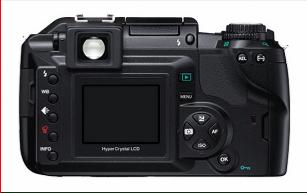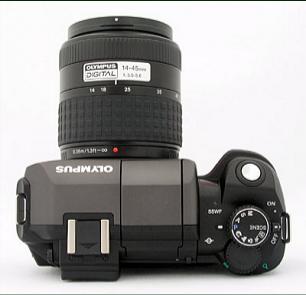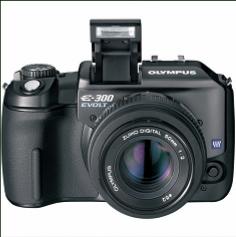THE ANNOYING STUFF
Every camera system has its design flaws glitches and "What were they thinking!" issues. The E-300 has a few to, and the most annoying of these is that leaving the camera in the on position drains the battery when the camera goes into sleep mode. I have found that the battery lasts all day without a problem but I often forget to shut the switch off at the end of the day only to find the camera dead the next time I pick it up. Poor engineering!
Update! Since I wrote this I have purchased an E-300 and this copy of the camera does not exhibit the battery drain problem when the switch is left on so I must conclude that was a fault in my original sample.
I also find that the viewfinder is small with the eye piece even smaller yet. It is difficult to get your eye in position to see the full field of view. I often hold the camera in odd positions with my body and head at unusual angles. The viewfinder and eyepiece make it harder to see well into the camera to compose the picture.
During my time with the camera I almost exclusively used it in the program mode and found that the decisions the camera made were quite to my liking. The only complaint I have was that in low light the camera will pick a low shutter speed instead of raising the ISO up from 100. I would much prefer a camera, even this one, with poorer noise performance, raise ISO freely to up to 400 in order to keep shutter speed up and avoided blur.
I also found that it was easy to inadvertently turn the Mode selection wheel when turning the camera on or off.
SUPERSONIC WAVE
The one very unique feature about the E-300 is Olympus's sensor cleaner that works by sending very high frequency vibrations through the sensor thereby knocking dust off. This reportedly does work but I cannot comment on its effectiveness as I did not have the camera long enough to fully check this out and I did not change lenses. However, I did not notice any dust spots in the shots I took.
INCLUDED LENS
Of course being a true SLR the E-300 can take a number of available lenses. The camera came with the Olympus Zuiko 14-45mm lens. With the 4/3rds sensor I find this range very useful equaling about 28-90mm on a 35mm camera. I did some very simple lens tests finding that what I observed agreed very closely with the DP Review. That is, offering good resolution but slightly soft at 45mm with the best arperture being the ever wonderful f/8. However I came to a different conclusion in regards to purple fringing. I found fringing occurring in several frames with highly backlight skies where the background was overexposed. This did seem to only occur at the 14mm setting.
____________________________________________________________
FLASH
The built in flash is well powered and provides even lighting at all lens ranges and is quite capable even in dark conditions. The E-300 flash does not automatically open however, but does have a convenient thumb button making popping it up easy.
Focusing is reasonably fast and acceptable even in dim conditions although not as good as the Canon Rebel. Olympus uses the Canon system of short bursts of flash to aid in focusing in the dark however this can be turned off to prevent annoying focusing attempts.
IMAGE QUALITY
E-300 pictures are satisfying with typical good Olympus balance, good contrast and color that is nicely rendered. Unfortunately though, the noise performance of the E-300 is no match for the Canon Rebel. I had hoped for better competition to the Canon Rebel but the camera only produces noise free images at ISO 100. A small amount of noise is just noticeable at ISO 200, ISO 400 and 800 are usable but not on par with Canon. This is somewhat to be expected given that smaller sensors, like the 4/3 sensor that Olympus has adopted, are inherently more noisy. Canon in particular has excelled in producing low noise sensors even when compared to the same sized chips from the competition. So where does this leave the E-300 in overall terms of image quality? The real indicator of image quality is if there is general happiness with the images produced during a period of time and on this score the E-300 does well. In absolute terms are the pictures as good as the Canon Rebel? No, but the camera certainly does produce pleasing useful pictures and is much better than any Digicam that I have tested including the Sony 828. The E-300 in my opinion is not as good an imager as the Canon 6.3 megapixel Rebel but Image quality alone would not keep me from having this camera.
LCD DISPLAY
High quality displays have been finding their way into even the lower priced digicams and this one is no exception being bright and well adjusted for color and contrast, however, a bit on the small side. It can be set to show much of the shooting information during operation if desired, being that the E-300 lacks a dedicated display for such information.
CONSTRUCTION
As I said earlier, the E-300 has a nice feel in your hands and this also is true of the construction quality. Supposedly it has a plastic body however it looks and feels very sturdy. The Canon Rebel, in comparison, does have a very plastic feel giving senses of cheapness that does not exist with the Olympus. The E-300 also has a nice rubberized hand grip and the buttons feel solid when you press or turn them. I know it is the image that counts, but the camera has a very satisfying wining cr-chunk to the sound of the shutter.
CONCLUSION
How then do I conclude my thoughts on this camera?
Even though I was somewhat disappointed with picture quality I have a liking for the E-300. Perhaps it is the way it fits my hand, or perhaps my fondness for my original E-10. The camera is a nice walk around camera, when equipped with the 14-45mm lens, and takes good pictures. Equipped as such it is well suited for snapshots and documentary type photos, in other words, a very nice family camera. But it is also an SLR and has the ability to take a number of other lenses up to a new 300mm 2.8 allowing for great versatility. It should be noted however, Olympus does not have any provision for image stabilizing either in the camera, like Minolta or in their lenses like Canon. Of course there is also full ability to control the camera settings and modes satisfying the advanced user. I think the E-300 is a great camera to transition into digital from 35mm SLR.
The problem comes in relative to price point and the competition. When I started this review the Olympus E-500 was not out yet and the E-300 cost about $750. Now the street price is down to about $670. The E-300 is, in my opinion, not as good as the 6.3 megapixel Canon Rebel which, up till recently, was readily available new for about $800, with lens. The Rebel is slightly better in focus and speed performance and has the better image chip. If both these cameras could be had for similar price, to me, there is no contest, the Rebel is the winner with clearly the best pictures and performance plus the vast selection of old and new lenses. Now with the E-500 out, the balance could change, but I suspect not, I suspect that the same difference will hold true between the E-500 and the Rebel XT but perhaps even more so if Olympus has not significantly improved image and noise performance from the E-300. I like the Olympus at substantial savings over the Rebels but at or near the same price I would go for Canon.
Bring the price of the E-300 to $550 or less and I would like to have one.





